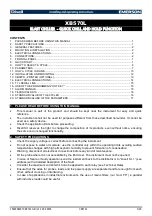
1 2 2 . 2 3
D I A . H O L E
D I A .
L 2 2 . 2 1
C I A .
F I E L D
F A C T O R Y
I S I N A C C O R O A N C E
W I T H
N A T I O N A L
E L E C T R I C A L C O D E
I N E C . ,
A N Y
O R A D D I T I O N S M U S T B E
C O M P L I A N C E W I T H A L L A P P L I C A B L E C O D E S .
2 .
S E P A R A T E S O U R C E
J S E D 3
O
F
T O
7 .
T H E U N I T
C O N T R O L
3 . A L L
3 6 3 V A
LEGEND:
S T A R T E R
START-UP
5.
Initial Check
Do not attempt to start the liquid
chiller, even momentarily, until the following steps have
been completed.
1. Check all auxiliary components such as chilled Iiquid
circulating pump, air handling equipment, or other
equipment to which the chiller supplies liquid. Con-
sult the manufacturer’s instructions. If used, pump
auxiliary
contactor
and flow switch interlocks must
be properly installed (see Fig. 8, Typical Wiring
Schematic).
7.
8.
9.
10.
11.
2. Check chilled water safety thermostat. See Safety
Thermostat (page 12) for adjustment.
3. Backseat
(open) compressor suction and discharge
shutoff valves. Close valves one turn to allow pres-
sure to reach test gages.
4. Open liquid line valve.
5. Fill chilled liquid circuit with clean water (with rec-
ommended inhibitor added) to be cooled. Bleed all
air out of high points of system.
12.
13.
Fig. 8
Wiring Schematic
Set temperature controller (see Multiple-Step
Controller).
Check tightness of all electrical connections.
Compressor oil should be visible in sightglass (see Oil
Charge).
Be sure there are no refrigerant leaks (see Leak Test
and Dehydration).
Be sure unit is fully charged with refrigerant (see
Refrigerant Charge).
Electrical power source must agree with nameplate
rating.
Crankcase heater must be firmly locked into com-
pressor crankcase.
Be
sure crankcase is warm (heater
should be on for 24 hours before starting compressor).
Be sure compressor floats freely on the mounting
springs. See Compressor Mounting section and Fig. 3
for loosening compressor bolts.
9






































